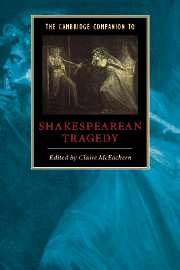Book contents
- Frontmatter
- 1 What is a Shakespearean tragedy?
- 2 The language of tragedy
- 3 Tragedy in Shakespeare’s career
- 4 Shakespearean tragedy printed and performed
- 5 Religion and Shakespearean tragedy
- 6 Tragedy and political authority
- 7 Gender and family
- 8 The tragic subject and its passions
- 9 Tragedies of revenge and ambition
- 10 Shakespeare’s tragedies of love
- 11 Shakespeare’s classical tragedies
- 12 The critical reception of Shakespeare’s tragedies
- 13 Antony and Cleopatra in the theatre
- Select bibliography
- Index
- Series List
12 - The critical reception of Shakespeare’s tragedies
Published online by Cambridge University Press: 28 May 2006
- Frontmatter
- 1 What is a Shakespearean tragedy?
- 2 The language of tragedy
- 3 Tragedy in Shakespeare’s career
- 4 Shakespearean tragedy printed and performed
- 5 Religion and Shakespearean tragedy
- 6 Tragedy and political authority
- 7 Gender and family
- 8 The tragic subject and its passions
- 9 Tragedies of revenge and ambition
- 10 Shakespeare’s tragedies of love
- 11 Shakespeare’s classical tragedies
- 12 The critical reception of Shakespeare’s tragedies
- 13 Antony and Cleopatra in the theatre
- Select bibliography
- Index
- Series List
Summary
This chapter offers a sketch in broad strokes of some of the main trends in critical reaction to and theories about Shakespeare's tragedies since the late seventeenth century. By this time the culture of Shakespeare's age had come to seem crude and barbarous to educated Londoners, distanced as it was by the restoration of Charles II in 1660, the influence of French drama, the introduction of actresses playing female parts, and the restrictive licensing of only two indoor theatres that targeted moneyed patrons. The first critical writings on Shakespeare's works began to appear before the end of the century, though as an industry Shakespearean criticism developed during the eighteenth century, fostered by the spate of editions of the plays that followed that of Nicholas Rowe, published in 1709. For almost a century after Thomas Rymer’s A Short View of Tragedy was published in 1693, editors and critics felt obliged to consider Shakespeare in relation to what were called the ‘Rules of Art’, rules derived from the French and from Horace, though often ascribed to Aristotle, especially the three unities of time, place, and action. Shakespeare was regarded as a prodigy, whose ‘wild and extravagant’ works possessed genius but lacked refinement, the ‘Turn and Polishing of what the French call a Bel Esprit’.
- Type
- Chapter
- Information
- The Cambridge Companion to Shakespearean Tragedy , pp. 224 - 240Publisher: Cambridge University PressPrint publication year: 2003



